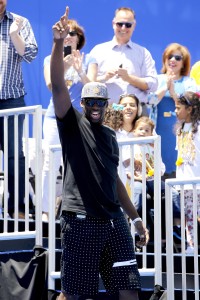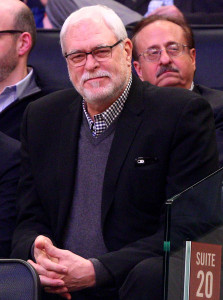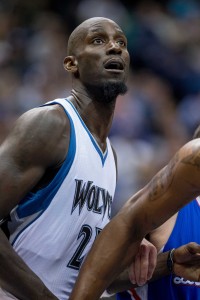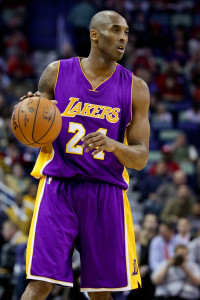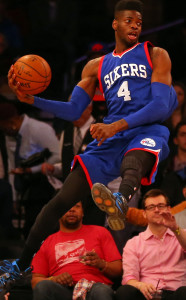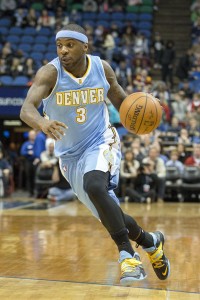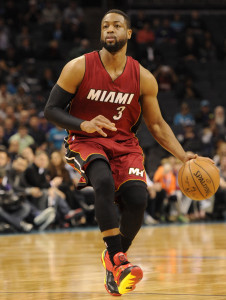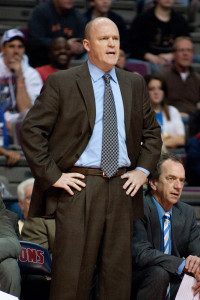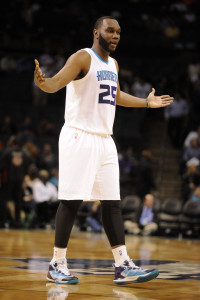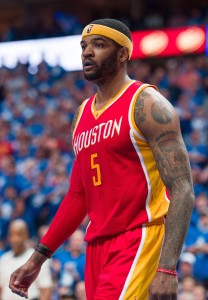Guaranteed Contracts
- Klay Thompson ($15,501,000)1
- David Lee ($15,493,680)
- Andrew Bogut ($12,000,000)
- Andre Iguodala ($11,710,456)
- Stephen Curry ($11,370,786)
- Shaun Livingston ($5,543,725)
- Harrison Barnes ($3,873,398)
- Festus Ezeli ($2,008,748)
Non-Guaranteed Contracts
- James Michael McAdoo ($845,059)2
Options
- Marreese Speights ($3,815,000 — Team)3
- Brandon Rush ($1,270,964 — Player)4
Restricted Free Agents/Cap Holds
- Draymond Green ($2,725,003) — $2,725,003 qualifying offer5
- Justin Holiday ($1,147,276) — $1,147,276 qualifying offer6
- Ognjen Kuzmic ($1,147,276) — $1,147,276 qualifying offer7
Unrestricted Free Agents/Cap Holds
- (Jordan Crawford $5,406,048)8
- (Jermaine O’Neal $2,400,000)8
- Leandro Barbosa ($947,276)
- No. 30 pick ($943,300)
Draft Picks
- 1st Round (30th overall)
Cap Outlook
- Guaranteed Salary: $77,601,793
- Non-Guaranteed Salary: $745,059
- Options: $5,085,964
- Cap Holds: $14,716,179
- Total: $98,148,995
Continuity is a word rarely attached to any team’s offseason strategy. Most franchises spend those months upgrading at positions of need, executing a rebuilding plan, retooling with young players or making flashy moves. Even many championship teams rarely stand pat, either out of necessity because of salary issues or free agency, or under the assumption they cannot repeat without a different mix.
Not so with the Golden State Warriors. Their avowed goal this offseason, as GM Bob Myers declared after the team’s first title in 40 years, is to keep their young core intact. Considering that all but one of their starters is 27 years old or younger, that’s not surprising. Sure, they’d like to make a couple of tweaks but the Warriors seem poised to defend their title with most, if not all, of their rotation players returning in their same roles.
“When you have the success that we had, you like to keep it together as much as possible,” Myers said during his postseason press conference. “It doesn’t mean you don’t open your eyes to see what else is out there, but if it’s a close call, you always want to retain the talent that got you a championship.”
Golden State’s front office has one major order of business this summer — retaining its best frontcourt player, Draymond Green. That will come at a high price financially but there’s little chance that Green will wind up in another uniform. Green, who is represented by former NBA player B.J. Armstrong of the Arn Tellem-led Wasserman Media Group, is due for a massive increase in pay after making less than $1MM this past season. It’s expected that the restricted free agent will command a max level contract or something in that ballpark with a starting salary of approximately $16MM.
Green has emerged as one of the league’s top two-way players and should have his share of suitors. There were rumblings during the season that the Pistons would make a strong push for Green, who grew up in Michigan and developed into an All-American talent under coach Tom Izzo at Michigan State. But while the Warriors cannot address the situation publicly, they have quietly made it known that they will match any offer that comes his way. Green himself said he wasn’t going anywhere, though that proclamation came during the euphoria of the championship celebration.
It may actually be in the Warriors’ best interest if Green signs an offer sheet. That would allow them to lock up Green for another three or four seasons without any tricky negotiations. While it’s almost unfathomable to believe that Green would sign his qualifying offer of $2.725MM, he could attempt to work out a shorter deal with the Warriors that would allow him to swiftly re-enter the market as an unrestricted free agent.
The tricky part for the club is securing Green’s services long term while avoiding the dreaded luxury tax in the short term. They have $77.6MM in salary commitments for next season with the tax line projected to come in at $81.6MM. The easiest way to stay under the tax threshold is to deal David Lee‘s expiring contract of approximately $15.49MM and that’s the most likely outcome. While Myers hasn’t committed to doing that, it’s the only viable way to avoid the luxury tax without dealing one of those core players. Though Lee played a valuable role in the NBA Finals, he dropped out of coach Steve Kerr‘s rotation during the regular season.
Naturally, everyone around the league is well aware of the Warriors’ predicament and Golden State may have to give up an additional asset or two, such as draft picks, to make the deal happen. The Jazz reportedly engaged in serious discussions with the Warriors about acquiring Lee at the trade deadline and he could still help Utah and many other teams with his offensive skills. But no team has a trade exception big enough to absorb Lee’s contract, so the Warriors must find a trade partner with at least that much cap space or one that possesses some major non-guaranteed contracts. A third party might be required to pull it off.
A big reason why the Warriors have so much guaranteed money tied up is that they were proactive in re-signing the Splash Brothers. Klay Thompson‘s four-year extension with a starting salary of $15.5MM kicks in next season. The contract of reigning league MVP Stephen Curry has two years remaining and he will make the bargain basement rate of $11.37MM next season.
Once the Green-Lee issues are decided, the Warriors can focus on working out a contract extension with Harrison Barnes. Both parties are interested in getting something done by the October 31st deadline and it’s estimated that Barnes will command an annual salary in the $10MM-$12MM range. That wouldn’t affect the Warriors’ bottom line next season, since the extension would kick in for the 2016/17 season when the league’s salary cap is expected to dramatically increase.
The team’s only unrestricted free agent is veteran reserve shooting guard Leandro Barbosa, who was part of Kerr’s rotation most of the season. If Barbosa does not return, they will be in the market for a backup shooting guard. The Warriors also have to decide whether to exercise their $3.815MM team option on Marreese Speights — an unlikely prospect considering their cap situation — and extend qualifying offers to Justin Holiday and Ognjen Kuzmic.
They can add depth with their first-round pick at No. 30 overall (they don’t have a second rounder) and through free agency via exceptions. They have the mid-level and bi-annual exceptions available if they can avoid the luxury-tax apron. Otherwise, they’d be limited to the taxpayer mid-level exception of $3.376MM.
That’s how they could make those aforementioned tweaks. Otherwise, the Warriors seem content to bring the not-so-old gang back and stay the course.
Cap Footnotes
1 — Thompson’s salary will be the league’s maximum salary for a player with four years of experience or $15,501,000, whichever is less.
2 — McAdoo’s salary is partially guaranteed for $100,000.
3 — The cap hold for Speights would be $4,754,750 if the Warriors decline their team option on him.
4 — The cap hold for Rush would be $947,276 if he opts out.
5 — The cap hold for Green would be $947,276 if the team decides not to tender a qualifying offer.
6 — The cap hold for Holiday would be $947,276 if the team decides not to tender a qualifying offer.
7 — The cap hold for Kuzmic would be $947,276 if the team decides not to tender a qualifying offer.
8 — See our glossary entry on cap holds for an explanation of why these players technically remain on the books.
The Basketball Insiders Salary Pages were used in the creation of this post.
